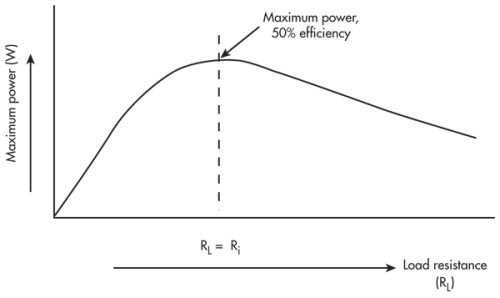-
Electric currentThe rate of flow of charge
-
Potential differencework done (energy transferred) per unit charge
-
Resistancea measure of how difficult it is for charge carriers to pass through a component
-
Potential difference equationWork done (W)/ Charge (Q)
-
Resistance equationPotential difference(V) / Current (I)
-
Energy change equationnumber of kg x joules per kg difference
-
Graph of energy coulomb vs distance
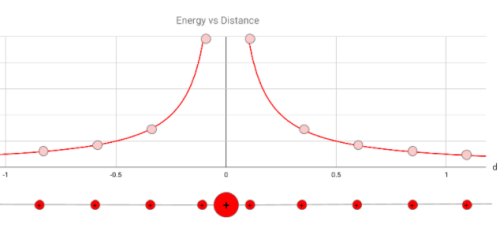
-
The closer one (like) charge is to another...More work was done to get it there, because it had to be ushed further against an increasingly bigger force and so the more EPE
-
Electrical potential energyfor ONE particular object in one place
-
Electrical potentialtells you the energy of ANY object at that place, as long as you know its charge
-
Electrical potential definitionElectrical potential energy per coulomb
-
The nearer a charge is to another...the greater the electrical potential it has
-
Energy transferred (J) equationNumber of Coulombs x Potential energyE = QV
-
Pushing charges of the same sign...gives it energy, we know this because when you let it go it rushes away and gains kinetic energy. That energy must have already been there as potential energy.
-
The nearer the two charges...the bigger the forces pushing them apart
-
The faster one chaeged particle rushes away from the other...the more energy it has
-
What is charge?A basic property of matter
-
What are the two forms of charge?Positive and negative
-
In most electric circuits what do electrons do?Move and transfer energy
-
What objects can be charged up?Insulators
-
What objects conduct charge (away to Earth)conductors
-
What is charge measured inCoulombs (C), amps per second
-
Charge of one electron-1.6x10^-19C
-
What is current?The flow of charge
-
What is current measured inAmps (A), coulombs per second
-
Is current a fundamental unit?Yes, the base electrical quantity is current all other electricl quantities derive from it
-
Current equationchange in charge/ change in time ( I = ∆ Q/ ∆ t )
-
When one ampere flowsone coulomb of charge passes a given point in a circuit each second
-
Ohm's lawfor an ohmic conductor, current is directly proportional to the potential difference across it, given that physical conditions are kept constant
-
Potential difference (voltage) equation interms of ohm's lawV = IR
-
Current voltage graph for semiconductor diodes
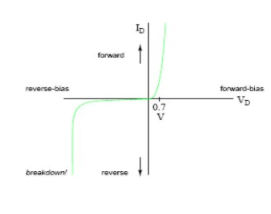
-
semiconductor diode forward biasis the direction in which it will allow current to flow easily past the threshold voltage (the smallest voltage needed for current to flow, usually 0.7V)
-
semiconductor diode reverse biasIn the direction of the reverse bias, the resistance off the diode is extremely high meaning that only a very small current can flow.
-
semiconductor diode forward bias resistanceThe current gets very big quickly as resistance decreases
-
What happens at ~ -50V for semiconductor diode reverse biasthe diode breaks down so the current increases
-
Current voltage graph & voltage current graph for filament lamp
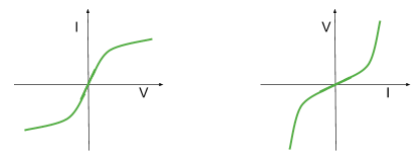
-
As current increases for the filament lampThis component heats up as current increasesSo the resistance of this component increases as current increases
-
filament lamp at low currents vs higher (ohm's law)At low currents the metal wire will not heat up significantly therefore for very low current, Ohm’s law is obeyed, but as current increases (in either direction) the graph begins to curve due to the increasing resistance (due to the wire heating up)
-
Negative current direction vs positive direction for IV & VI graph for filament lampNegative current direction is the exact same thing in the positive direction but reversed and so the graph is symmetrical
-
The higher the resistance of the componentthe hotter and brighter it will get
-
The current passing through the filament of the light bulb is the same as the current passing through the leads.So why does the filament glow and heat up while the leads do not?The filament has much higher resistance than the leads.It is made of a different metal (tungsten rather than copper), it is longer, it is thinner and it works at a higher temperature.
-
Light dependent resistor (LDR)Resistance decreases as light intensity increases
-
ThermistorResistance decreases as temperature increases
-
Light emitting diode (LED) note for diagramfor diodes the direction of the triangle is the direction of current
-
Diagram for Diode, LED, Thermistor and LDR
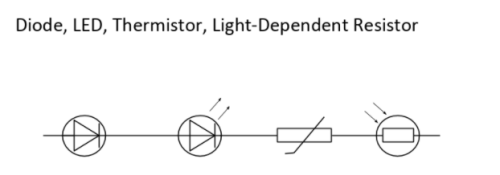
-
Resistance equation (in terms of resistivity)resistivity x length/cross-sectional area (R=ρ *L/A)
-
Resistivity equationresistance x cross-sectional area/length (ρ = R * A/L)
-
Resistivity definitionis the nature of the material to resist current (measured in ohm m ), it’s a way to compare different materials to each other
-
Resistance of a component in a circuit meaningis a measure of the difficulty of making current pass through the component
-
What does resistance do?Resistance restricts the flow of charge so it makes the current smaller
-
What is resistance caused by?the repeated ‘collisions’ between the charge carriers in the materials with each other and with the fixed positive ions in the materials
-
When a metal wire is placed in an electric circuit, the potential difference from the battery...makes the electrons flow through the wire (current). As they do so, they collide with the metal ions and this slows down the flow.
-
What does resistance indicate?the potential difference needed to make 1 amp of current flow.
-
If a component has a high resistance (pd)a large potential difference is needed for a given current
-
Effect of temperature on the resistivity of metalsIncreasing the temperature of a metal causes the ions in the wire to vibrate faster and more as they gain KE. This increases the number of collisions the charge carriers ( in metals conduction electrons)and so are likely to have which slows them down resulting in a lower current Higher temperature -> lower current -> higher resistivity
-
Effect of temperature on the resisitivity of semi-conductorsIncreasing the temperature in a semi-conductor causes an enormous release of new charge carriers. This reduces resistivity dramatically.Higher temperature -> higher charge carrier density -> higher current -> lower resistivity
-
Factors impacting resisitanceLength, cross sectional area, type of wire
-
How does length impact resistance?the longer the wire the larger the resistance as electrons collide with more ions as they pass through
-
How does the cross sectional area impact resistance?the larger the cross sectional area the smaller the resistance, as there are more routes for charge carriers/ electrons to travel and less dense metal
-
How does the type of wire impact resistace?conductivity or resistivity of wire varies from wire to wire
-
Resistors in series equationRtotal = R1+ R2 + R3...
-
Resistors in parallel equation1/RT = 1/R1 + 1/R2 + 1/R3 ...
-
energy equationCurrent x Potential difference x time
-
Electrical power equationCurrent x Potential difference = Current^2xResistance = Potential difference^2/Resistance P = IV = I^2R = V^2/ R
-
current in a series circuitThe current is the same everywhere in the circuit
-
potential difference in a series circuitThe battery potential difference is shared across all elements in the circuit, therefore the total sum of the voltages across all elements is equal to the supply potential differenceThe total voltage across the cells is equal to the sum of the individual voltages of the cells : VT = V1 + V2 + V3 …
-
current in a parallel circuitThe sum of the currents in each parallel set of branches is equal to the total current
-
Potential difference in a parallel circuitThe potential difference across each branch is the sameThe total voltage is equal to the voltage of one cell. This is because the current is split equally between branches, therefore the overall potential difference is the same as if the total current was flowing through a single cell: VT = V1 = V2 = V3…
-
In DC circuits what is conserved?charge and energy are always conserved
-
Kirchoff's first law
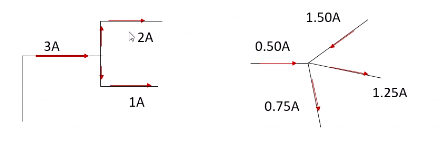 the total current flowing into a junction is equal to the current flowing out of that junction. This shows that no charge is lost at anypoint in the circuit, conservation of charge principle
the total current flowing into a junction is equal to the current flowing out of that junction. This shows that no charge is lost at anypoint in the circuit, conservation of charge principle -
Kirchoff's second lawaround any closed loop in a circuit the (vector) sum of all voltages (potential differences) in a series circuit is equal to 0. This shows that no energy is lost at any point in a circuit, Conservation of energy principle.
-
What is a potential divider?is a circuit with several resistors in series connected across a fixed voltage source, used to produce a required fraction of the source potential difference, which remains constant
-
Potential divider in a circuit propertiesThe potential difference of the source is divided between the components in the circuitThe ratio of the voltages is equal to the ratio of the resistors
-
Why would you use a potential divider?We use a potential divider circuit when we want to use only part of the voltage provided by the batteryThe potential divider used to supply constant or variable potential difference from a power supply
-
What can variable resistors be used for?Variable resistors can be used to trigger certain events.
-
How does an LDR work?in the circuit a LDR (resistivity decreases as light intensity increases, when it gets darker the resistance increases) is used, as the light intensity falls the resistance across R1 will increase so the circuit current decreases and resistance across R2 decreases, so the potential difference decreases If you want this effect reversed switch the position of the LDR and resistor and so the potential difference out would increase as light intensity decreased and the circuit could go on to cause a light bulb to be switch on because a threshold voltage has been met.
-
Real life uses of LDRfridge
-
What does a temperature sensor consist of?A temperature sensor consists of a thermistor and a variable resistor with potential difference source
-
What does a potentiometer do and how does it work?To supply a variable output pd, the input is connected to a length of uniform resistance bare wire. A sliding contact on the wire can then be moved along the wire giving a variable output pd between the contact and the one end of the wire.
-
potentiometer diagram
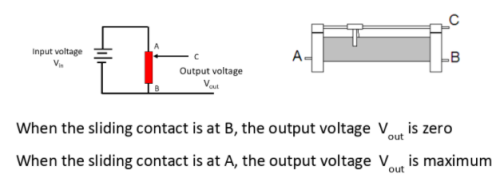
-
Potentiometer used as a dimmer switch diagram
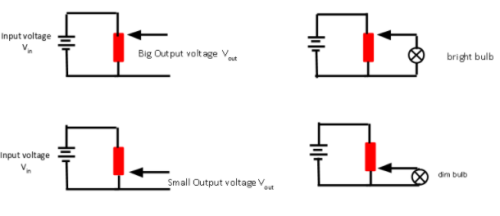
-
Do batteries have an internal resistance?yes, batteries have an internal resistance which is caused by electrons colliding with atoms inside the battery
-
consequences of batteries having an internal resistancesome energy is lost before electrons even leave the battery, It is represented as a small resistor inside the battery
-
what is electromotive force?is the energy transferred by a cell per coulomb of charge that passes through it (the amount of energy put in the circuit per coulomb of charge)
-
what devices give out emfAny device putting energy into a circuit is providing an electromotive force (emf)
-
what do devices taking in emf have?any device taking it out emf has a potential difference across it
-
can emf be recorded in a broken circuit?yes
-
when the cell is supplying no current... (emf)terminal potential difference = emf
-
When the cell supplies currentthe terminal potential difference decreases, the larger the current you draw the less terminal potential difference
-
Electromotive force equationsε = E/ Q = V(terminal potential) + v(lost volts) = I(R+r)
-
The potential difference available to the circuit equationsV = ε - Ir
-
in a V against I graph what is r (internal resistance) and εV against I graph r = -gradient, and the ε is the y-intercept
-
terminal potential difference equationV = IR
-
lost volts equationv=Ir
-
Power supplied by the cell equationPower supplied by the cell = εI = I2(R+r)This shows that the power supplied by the cell = power delivered to the load + power wasted in the cell (due to internal resistance)
-
power (external resistor)Power = ε2R/R+r
-
total resistance equationInternal resistance + load resistance = Total resistance (r + R = RT)
-
What is terminal potential difference (V)?The potential difference across the resistor R is known as the terminal potential (V) difference
-
What is lost volts?the potential difference across the resistor is known as lost volts (v) as this value is equal to the energy wasted by the cell per coulomb of charge
-
Power vs resistance graph
